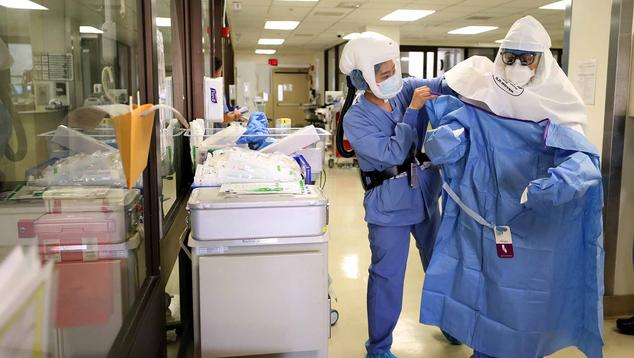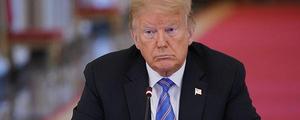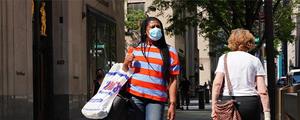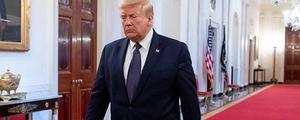Story Highlights
- Largest increases versus 2019 are for medical system and public schools
- Record-low confidence in police, 5-point decline since last year
- Majority-level confidence in small business, military and medical system
WASHINGTON, D.C. -- Americans express higher levels of confidence than they did last year in two U.S. institutions that have been particularly challenged during the coronavirus pandemic -- the medical system and public schools.
Since the virus swept across the U.S. earlier this year, medical workers have been on the front lines treating those sickened, with hospitals filled to capacity in some areas. This has presumably contributed to the 15-point one-year increase in the percentage of U.S. adults who now say they have "a great deal" or "quite a lot" of confidence in the medical system -- the highest on record since Gallup began tracking it in 1993.
Confidence in the public school system also rose this year -- by 12 points -- to 41%, its highest point since 2004. This record one-year boost in confidence for schools comes as American public school teachers, administrators and staff, who worked to educate the nation's children from a distance in the spring, are now facing another complicated school year.
Americans' improved confidence in medicine and public schooling is in line with data from Gallup's COVID-19 tracking panel survey, which has found broad approval of the handling of the crisis by hospitals and schools.

Line graph. Percentages of Americans who have a great deal or quite a lot of confidence in the medical system since 1993 and public schools since 1973. Confidence in these institutions is up by 15 and 12 percentage points, respectively. Currently the medical system has a 51% confidence score and public schools have a 41% confidence score.
These findings, from a June 8-July 24 poll, are the latest in Gallup's tracking of the public's confidence in an array of institutions, which began in 1973 during the Watergate scandal. The measure ranks U.S. institutions, based on the percentage of U.S. adults who say they have a "great deal" or "quite a lot" of confidence in the institution.
Double-digit increases in confidence for any institution are exceedingly rare. This has occurred only nine times in more than four decades of measuring confidence. Many of these involved heightened confidence in the military when the U.S. was at war or reflected significant changes in presidential job approval ratings.
| First Year | Second Year | Change | |||||||||||||||||||||||||||||||||||||||||||||||||||||||||||||||||||||||||||||||||||||||||||||||||
|---|---|---|---|---|---|---|---|---|---|---|---|---|---|---|---|---|---|---|---|---|---|---|---|---|---|---|---|---|---|---|---|---|---|---|---|---|---|---|---|---|---|---|---|---|---|---|---|---|---|---|---|---|---|---|---|---|---|---|---|---|---|---|---|---|---|---|---|---|---|---|---|---|---|---|---|---|---|---|---|---|---|---|---|---|---|---|---|---|---|---|---|---|---|---|---|---|---|---|---|
| % | % | pct. pts. | |||||||||||||||||||||||||||||||||||||||||||||||||||||||||||||||||||||||||||||||||||||||||||||||||
| The presidency (2008-2009) | 26 | 51 | 25 | ||||||||||||||||||||||||||||||||||||||||||||||||||||||||||||||||||||||||||||||||||||||||||||||||
| The military (1990-1991) | 68 | 85 | 17 | ||||||||||||||||||||||||||||||||||||||||||||||||||||||||||||||||||||||||||||||||||||||||||||||||
| The medical system (2019-2020) | 36 | 51 | 15 | ||||||||||||||||||||||||||||||||||||||||||||||||||||||||||||||||||||||||||||||||||||||||||||||||
| The military (2001-2002) | 66 | 79 | 13 | ||||||||||||||||||||||||||||||||||||||||||||||||||||||||||||||||||||||||||||||||||||||||||||||||
| Public schools (2019-2020) | 29 | 41 | 12 | ||||||||||||||||||||||||||||||||||||||||||||||||||||||||||||||||||||||||||||||||||||||||||||||||
| The military (2008-2009) | 71 | 82 | 11 | ||||||||||||||||||||||||||||||||||||||||||||||||||||||||||||||||||||||||||||||||||||||||||||||||
| Congress (1984-1985) | 29 | 39 | 10 | ||||||||||||||||||||||||||||||||||||||||||||||||||||||||||||||||||||||||||||||||||||||||||||||||
| The presidency (2001-2002) | 48 | 58 | 10 | ||||||||||||||||||||||||||||||||||||||||||||||||||||||||||||||||||||||||||||||||||||||||||||||||
| The presidency (1996-1997) | 39 | 49 | 10 | ||||||||||||||||||||||||||||||||||||||||||||||||||||||||||||||||||||||||||||||||||||||||||||||||
| GALLUP | |||||||||||||||||||||||||||||||||||||||||||||||||||||||||||||||||||||||||||||||||||||||||||||||||||
In addition to the medical and public school systems, several other institutions have seen significant upticks in confidence since last year, including banks (+8 points to 38%), small business (+7 points to 75%) and the church or organized religion (+6 points to 42%). The increase in confidence in the church at least temporarily halts the long-term decline in its ratings. Confidence in banks has been nearly restored to what it was before the Great Recession and financial crisis, down just three points from the 41% rating in 2007, after falling as low as 21% in 2012.
Record Low Express Confidence in Police
At the same time that several institutions have engendered greater public confidence, one -- the police -- stands alone as seeing a significant decline in the past year. Confidence in the police fell five points to 48%, marking the first time in the 27-year trend that this reading is below the majority level. This drop follows the public outcry after George Floyd was killed during an arrest in Minneapolis in late May, which sparked nationwide protests against excessive use of force by the police. This measure has been as high as 64% in the past.

Line graph. Percentage of Americans who have a great deal or quite a lot of confidence in the police since 1993. The latest reading of 48% is the lowest on record and down 5 points since 2019.
Confidence in the police rose seven points among Republicans to 82% and dropped six points among Democrats to 28%. A forthcoming story will examine the racial differences in the ratings of the police and other institutions.
Confidence Rankings of Institutions
The military has been the top-ranked institution, or tied for the top, every year since 1986, and while that is still the case, the jump in confidence in small business has resulted in a statistical tie between the two. Small business (75%), the military (72%) and the U.S. medical system (51%) are the only institutions garnering majority-level confidence in 2020.
Of the 16 institutions included this year, those at the bottom of the list remain largely stable. Fewer than one in five Americans express confidence in Congress, television news and big business. This is the 14th consecutive year that Congress is the lowest-ranked institution.
Between roughly one-quarter and one-third of U.S. adults overall are confident in the criminal justice system, newspapers, organized labor and large technology companies, the last of which was measured for the first time this year. In addition to the aforementioned police, church, and public schools, banks, the presidency and the U.S. Supreme Court all receive middling confidence scores from the public.

Bar graphs. Americans' confidence in 16 institutions. Small business, the military, and the medical system are the only institutions in which majorities of Americans say they have a great deal or quite a lot of confidence.
Despite low ratings for most institutions, majorities have at least "some" confidence in each one.
Average Confidence Inches Up but Remains Low
Of the 16 institutions rated this year, Gallup has tracked 14 annually since 1993. Americans' average confidence in these 14 overall edged up slightly this year compared with the prior two years, from 33% to 36%. Yet, it remains below the 43% highs recorded in 2001-2004.

Line graph. Average confidence ratings for 14 institutions since 1993. The current 36% is a slight improvement from 33% in 2018 and 2019 but well below the 43% highest average on record in the early 2000s.
Bottom Line
Two institutions that have taken on tremendous risks and challenges during the pandemic to fulfill their respective duties for the U.S. public -- the medical system and public schools -- have earned significantly greater trust from Americans in the process. Several other institutions that have been affected by the pandemic -- small business, organized religion and banks -- have also seen a rise in confidence.
At the same time, confidence in the police has edged down to a record-low level amid nationwide protests against police treatment of minorities. U.S. lawmakers and the media continue to inspire little confidence from Americans. With many in the U.S. reliant on the media to get factual information about the pandemic, this is a concerning finding.
View complete question responses and trends (PDF download).
Learn more about how the Gallup Poll Social Series works.




